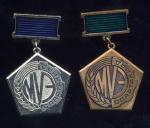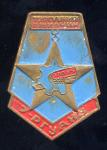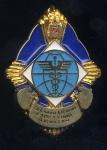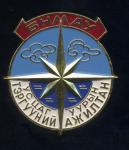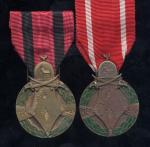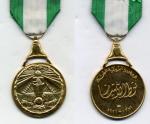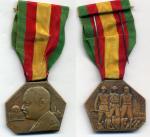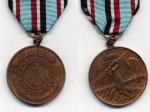-
Posts
14,343 -
Joined
-
Last visited
-
Days Won
25
Content Type
Profiles
Forums
Blogs
Gallery
Events
Store
Everything posted by Ed_Haynes
-
-
W NIB 05 and W NIB 06 -- Spartakiad of the Mongolian Trade Union Looks like this came in three classes?
-

Soviet Order of Stalin
Ed_Haynes replied to Bryan's topic in Russia: Soviet Orders, Medals & Decorations
Right, Jim! And turmning those stones over is such fun. -
-
-

Mongolia Mongolian Revolutionary Youth League (MRYL) Badges
Ed_Haynes replied to Ed_Haynes's topic in People's Republic Mongolia
-

Mongolia Mongolian Revolutionary Youth League (MRYL) Badges
Ed_Haynes replied to Ed_Haynes's topic in People's Republic Mongolia
-
E NIB 01 -- Common Control of the State Border For the Mongolian-Chinese border revision and control commission of 2002-2004.
-
-

Mongolia Socialist Labor Badges
Ed_Haynes replied to Ed_Haynes's topic in People's Republic Mongolia
-
-
Interesting question. But the problem is that we sit, here, many kilometers (most of us) and many years (all of us) away from the time and place and circumstances of the original decision. Until and unless someone takes the time and effort actually to look at the archival records and explore this question seriously, we'll just be wildly and irrelevantly guessing. I guess that is OK if it is fun, but let us not confuse this fun with anything that tells us anything at all about phaleristic history.
-
Thanks, Dave, it is difficult. And 'tis far from "rocket science". I have tended to go with the English transliteration that the majority of relevant friends in-country have tended to prefer (when such is available). For Egypt, I have been guided by the major late (and lamented) manufacturer of ODM in Cairo. I do this even if what I habitually use is linguisitically deviant. And I don't mind corrections, differences, alternatives. Honestly, I'd prefer just to show the Arabic and be done with it. (How do you do it? I have lost out on all such efforts, producing just gibberish. Using Hindi is worse.)
-
Medal for the 25th Anniversary of the Ba'ath Party For the 25th anniversary of the Ba'ath Party in Syria (1962-87?). Obverse: A silver shield-shaped medal, 35 x 41 mm. A volcano-like structure, spouting flames, with a cog-wheel behind. Above a roughly-painted depiction of the Iraqi flag and, below, the dates "1962 / 1987". Suspended from a ring. Reverse: An upright rifle, spear, spade, and crescent, with a legend on either side. Above, another legend. Above all, a sunburst design with a depiction of the Ba'ath Party flag in the upper center. Ribbon: 30 mm, white with two orange stripes toward each edge: 1 mm white, 3? mm orange, 2 mm white, 3? mm orange, 9 mm white, 3? mm orange, 2 mm white, 3? mm orange, 1 mm white,
-
Wisam al-Tadrib / Medal of Training Awarded to officers in command of a unit of at least company size which has achieved high ratings in training exercises over a period of at least one year. During this time, the recipient must have served actively with his unit and displayed a documented high standard of conduct and behavior. Subsequent awards are indicated by the addition of a bronze oak leaf to the ribbon. This medal was also awarded to Saudi Arabian troops. This medal has also been incorrectly associated with the Syrian Golan Heights campaign of 1973-74. Obverse: A 42-mm five-pointed gilt star with a circular center bearing a green-enameled helmet, crossed anchor and rifle, with horizontal wings; through all, there is an upright torch with red-enameled flames. Above and below, Arabic inscriptions; "To sweat in peace saves pain in war" above and "Wissam al-Tadrib" or "Medal of Training" below. Suspended by a ring. Reverse: Plain. Ribbon: 31 mm, divided into three equal stripes (left to right) of blue, bluish white, and medium green. A bronze oak leaf is worn on the ribbon to indicate a second award. This ribbon has been sometimes incorrectly depicted as equal stripes of black, gray, and black.
-
Order of the Wounded Awarded to both military and civilian personnel who are wounded while performing services for the state. The medal may be awarded to non-Syrians, though it is not awarded posthumously. Under conditions of special bravery, the medal is usually presented personally by the commander-in-chief (the Syrian president), indicating the prominence with which this award is viewed. This award has also been referred to in English as the "War Casualty Medal". Established: By Legislative Decree No. 165 of 4 July 1953. Obverse: A 37 mm five-pointed bronze star with rays between the points. The center has a wreath surrounding a central enameled circle of green and concentric circles (reading outward) of black, white, and red enamel. There is an upright sword overlaying the whole star. Suspended by a ring. Reverse: Plain. Ribbon: 37 mm, green with a 6 mm yellow stripe toward each edge: 2 mm green, 6 mm yellow, 19 mm green, 6 mm yellow, 2 mm green.
-
Order of the Palestine Campaign On 16 May 1948, one day after the united Arab declaration of war against Isarel, Syrian troops attacked across the Golan Heights. By 31 October, the Syrian war with Israel had ended unsuccessfully, as Syria had been forced back along most of their border with the Zionist state. Sporadic fighting continued until the armistice on 20 July 1949. Awarded for valor and service in the battles in Palestine in 1948. The medal may be awarded to foreigners and can be awarded posthumnously. There is some indication that award may have been extended beyond the initial period of service - for the 1948 war - and that it may have become a generalized award for service against Israel? This medal has also been referred to as the "Palestine Medal". The lack of Syrian success in the war, coupled with the massive number (over 100,000) of Palestinian refugees who moved into Syria, became one of the factors which would, over the following decades, encourage military intervention in the Syrian government. Established: By Legislative Decree No. 13 of 18 December 1951 and amended by Legislative Decree No. 9 of ???. Obverse: A 37 mm x 50 mm dark bronze, essentially circular medal if one ignores the upward extension, with a green-enameled laurel wreath above and below. In the center is a map of Palestine and the Jordan Valey. To the right the Arabic inscription "Palestine" and, to the left, the date "1948" (note the C.E. date). The medal is topped by crossed swords, and above that a dome-shaped depiction of a Christian church topped by a crescent. The actual ribbon suspension is by a rather crude loop attached on the upper reverse of the medal. Reverse: Plain, except for suspension loop. Ribbon: 38 mm, medium red with two black stripes. Red 7 mm, black 6 mm, red 12 mm, black 6 mm, red 7 mm. The ribbon has also been seen with red with a white stripe toward each edge. It is presentlky unknown what that signifies. Awards: Syrian forces number around 8000 troops, in two infantry brigades, a mechanized battalion, and a small air force.
-
Order of Civil Merit Awarded for service to the state and to wider Arab causes. In normal classes, a recipient begins in the lowest class and, over time, works their way un through the order by successive promotion, often after specified period of service in lower ranks of the award. The order may be presented posthumously. This order represents a revision and modification of the earlier, French-created Honor Medal of Syrian Merit. On occasion, this order has been referred to as the "Syrian Merit Medal". This award is also known, quite unofficially, as the "Order of the Arrows". The redesign of the earlier medal served to remove the overall design similiarity of the previous award to a "Star of David" by reducing the number of points of the star from six to five and resulted in a complete redesign of the reverse. Established: By Legislative Decree No. 153 of 25 June 1953. Obverse: A gilt circular, patterned plaque, with a gilt five-pointed, white-enameled star. The center enameled green in an open pentagonal shape. The overall impression is of five white arrowheads pointed outwards from a green center. Suspended by a ring. Reverse: Gilt with brown-enameled elaborate Arabic inscription. Ribbon: White with a green center stripe. first class - Excellent Class - sash (worn over ??? shoulder), sash badge and breast star (worn on ??? breast) second class - also termed First Class - silver-gilt and enamel neck badge (36-mm ribbon) and breast star (worn on ??? breast) third class - also termed Second Class - bronze-gilt and enamel neck badge (36-mm ribbon) (shown below) fourth class / officer - also termed Third Class - bronze-gilt and enamel breast badge, rosette decoration / knight - also termed Fourth Class - bronze enameled breast badge, 44 mm
-
By request ( ), I move on to Syria. Sources: http://faculty.winthrop.edu/haynese/medals/Syria/syria.html http://www.omsa.org/photopost/showgallery.php?cat=553 http://www.medals.org.uk/syria/syria.htm http://www.netdialogue.com/yy/Asia/Syria/Syria.htm http://www.coleccionesmilitares.com/cintas/cintasas.htm#s (click on his Syrian link)
-
Medal of Distinction Awarded to those who render valuable service to the state, especially in the fields of acience, arts, literature, agriculture, industry, commerce, sports, public services, and public order and security. Established: Established in 1966 and classified as a civil medal by Law No. 12 of 1972. Obverse: Circular 35-mm medal, a metaphorical scene depicting the beneficial spread of knowledge and culture among the people. (???!) Suspended by a straight bar from a ring in the form of an ancient Egyptian helment (crown?). (This description is pretty forced, but it is "official" = gag.) Reverse: The name of the medal, above an indication of the class and, below, the date of creation. Ribbon: 37-mm moir?, white with 10-mm green edge stripes: 10 mm green, 17 mm white, 10 mm green. first class - gilt (shown below) second class - silver third class - bronze
-
Medalyet Falasteen / Palestine Medal Awarded to Egyptian armed forces personnel who served in the 1948-49 Arab-Israeli War. In 1953, with the revolution, the design of the medal was altered, with the earlier reverse being worn as the obverse of the medal. Established: 1948?, revised ???? Obverse: 36 x 45 mm, bronze, seven-sided, with unequal sides, seeming "off balance" to the left (until 1953). first variety: King Faruq facing left [not, as it has sometimes been described, Nasser!], between the Egyptian parliament building (to the right) and the Al-Aqsa mosque in Jerusalem (to the left); above "Medalyet / Falasteen", or "Palestine / Medal". second variety: three soldiers, with civilians gathered around them, dated "1948-1347" or "1948-1347" (the reverse of the pre-1953 variety). Reverse: first variety: three soldiers, with civilians gathered around them, dated "1948-1347" or "1948-1347" (the obverse of the post-1953 variety). second variety: blank. Ribbon: 35 mm, equal stripes (5 mm each) of green, red, yellow, red, green. A brass lotus blossom has been observed worn on ribbon bars representing this medal, though it is unknown what this represents. first variety with the king on the obverse (shown below) second variety with the old reverse moved to the obverse
-
Twentieth Anniversary of the Revolution Commemorating the 20th anniversary of the revolution, 1972. Established: 1972? Obverse: Circular 33 mm bronze medal, in the center the eagle of the republic, surrounded by twenty stars. Above, the Arabic inscription and, below, a wreath. Suspended by a ring suspension. Reverse: A scene of a muscular arm holding a submachine gun and, behind, a hydroelectric dam (Aswan) and sun rising over a building on a hill (the Muhammad Ali Mosque in Cairo?). Ribbon: 36 mm, light blue with edge stripes (reading inward) of black, white, red, and central stripes of (left to right) red, white, black. Black 2? mm, white 2 mm, red 2 mm, light blue 7 mm, red 3? mm, white 2 mm, black 3? mm, light blue 7 mm, red 2 mm, white 2 mm, black 2? mm. When worn as a ribbon bar, a circular brass disk with "20" ("20") is usually added to the ribbon bar.
-
Medal for the Coronation of King Faruq, 1936 King Faruq was crowned as "King of Egypt and Sudan, Sovereign of Nubia, of Kordofan and or Darfur" on 28 April 1936. King Faruq abdicated after the revolution on 23 July 1952 and died in Rome on 18 March 1965. Established: Manufactured by Kramer (Cairo, Egypt). Obverse: Silver, 35 mm circular medal. Facing portrait of the king wearing fez and tuxedo, below, an Arabic inscription. Suspended by a ring. Reverse: At top, a crown with crescent with three stars above. A five-line Arabic inscription. Below, "KRAMER CAIRO". Ribbon: 36 mm, black with two thin medium blue stripes. Black 4 mm, medium blue 3 mm, black 22 mm, medium blue 3 mm, black 4 mm.
-
Medal of Muhammad Ali Awarded for service 19-26 November 1949. Commemorating the centenary of Muhammad Ali. Revised under the Republic? Established: By King Faruq, November 1949, later revised and continued under the Republic. Ribbon: 1?" moir? equal stripes of red, dark green, red.
-
Wisam Nigam al-'Askariia / Military Star The Military Star of Fuad I was originally intended for award to Egyptian and foreign officers for mention in dispatches or distinguished service in the field or before the enemy, with courage and a spirit of self-sacrifice. In broad terms, the Military Star can be seen as having been patterned after the British Distinguished Service Order. It was, of course, redesigned with the fall of the monarchy. With the redesign and restructuring which came with the 1952 revolution, the award came to be awarded to any officer for exceptional service with courage and a spirit of self-sacrifice. Whenever possible, the award is to be personally presented by the president of the republic. The star can be awarded posthumously or to foreigners. Established: By King Ahmad Fuad I in Royal Order of 6 December 1919, revised and redesigned on 9 July 1953 and amended by Law No. 12 of 1972. Obverse: A five-pointed gilt star, enameled white. The center is enameled blue with crossed swords in gilt, surrounded by a red circlet with a gilt wreath. Above all a gilt crown. Suspended from a straight bar suspender. After 1953, the 45-mm star has been of bronze with blue-enameled points, with the center swords replaced with the Egyptian eagle (after 1971, hawk), and the suspension crown removed. Each point has two crossed swords. The suspension is a ornate enameled bar in the form of a pair of "Pharonic" falcon's wings, with a disk in the center bearing a pair of crossed swords. Reverse: Until 1953, a gold Arabic inscription on purple enamel. Afer 1953, plain except for award details and the serial number of the decoration. Ribbon: 37 mm, moir?, five equal 6 mm stripes of blue, yellow, black, yellow, blue, with thin (1 mm) yellow edges. Military Star of Fuad I, 1919-1953 Military Star, 1953-- Egyptian eagle, 1953-58 U.A.R. eagle, 1958-71 hawk, post-1971 (shown below?)




